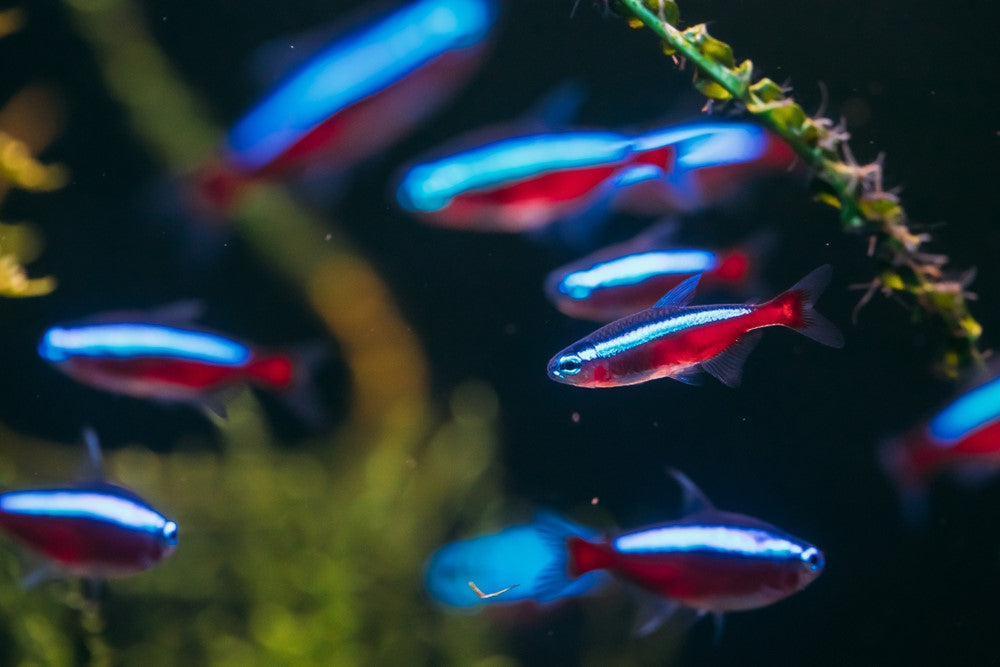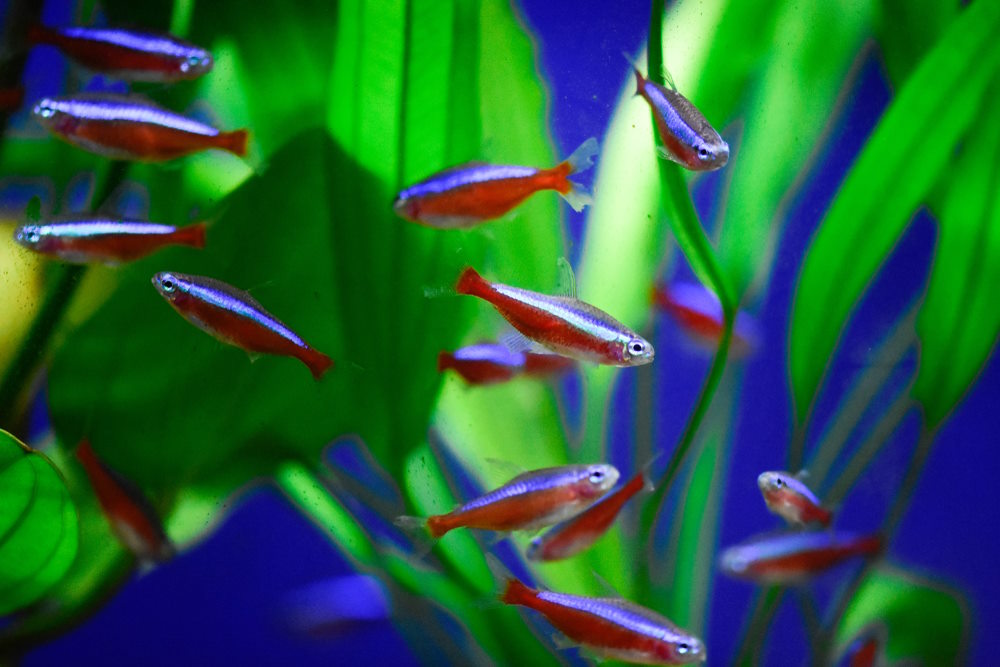Care Guide for Cardinal Tetras — Gorgeous Cousin of the Neon Tetra
Most people have heard of the neon tetra — an extremely popular, little fish that displays a pair of blue and red horizontal stripes. However, many veteran fishkeepers often prefer its more colorful, higher-priced cousin, the cardinal tetra. Imagine watching an entire school of these colorful jewels swimming back and forth in the midst of a forest of lush, green plants. Find out what it takes to keep this gorgeous species and why they’re totally worth saving up for.

Female cardinal tetra
What are Cardinal Tetras?
Paracheirodon axelrodi is known for being one of the most stunning schooling fish in the aquarium trade. Its common name refers to the very prominent, cardinal red stripe running horizontally down its body, which is paired with an iridescent blue stripe that is visible even when the fish tank lights are off. Personality-wise, they can be a little shy if you suddenly walk in front of the tank, but they are quick to come out of hiding, especially if you have a large school of them.
This species comes from the northern rivers of South America in countries like Brazil, Venezuela, and Columbia. Because of the huge fluctuations in river height between the wet and dry seasons, this species is usually an annual fish in the wild. However, they can live much longer in home aquariums and grow bigger than you’d expect.
What is the difference between cardinal tetras, neon tetras, and green neon tetras? These similar-looking relatives all have a blue horizontal stripe with a red stripe underneath it. The cardinal tetra is the biggest, grows up to 1.75 inches (4 cm) long in captivity, and has a full red stripe that stretches from the eye to tail. In the middle is the 1.25-inch (3 cm) neon tetra with a half red stripe that starts in the middle of their body and reaches the tail. The smallest is the 1-inch (2.5 cm) green neon tetra that has an iridescent turquoise stripe with only the faintest amounts of red.
Are cardinal tetras better than neon tetras? Both fish are similar in nature and have similar care requirements, so it comes down to personal preference. If you want to save on price, the neon tetra is the better choice. If you are drawn to the vibrant colors or want a slightly bigger fish, then go with the cardinal tetra. Whichever you choose, you can be sure they will be a beautiful addition to your tank.

Left to right: cardinal tetra (Paracheirodon axelrodi), neon tetra (P. innesi), and green neon tetra (P. simulans)
How to Set Up an Aquarium for Cardinal Tetras
The cardinal tetra lives in slow-moving waterways that are heavily shaded by rainforests and other thick vegetation. Their native habitats include both blackwater streams (with acidic pH, low minerals, and brown tannins caused by rotting leaves in the water) and clearwater streams (with nearly neutral pH and more plant growth). Because they come from diverse environments that experience annual flooding, this hardy species can be kept in pH levels of 4.0–7.5, soft to moderate hardness, and 73–84°F (23–29°C). As one of the smaller fish in the ecosystem, they are used to hiding from predators, hunting, and breeding along the river banks under the thick cover of live aquarium plants, leaf litter, and driftwood.
How many cardinal tetras should be kept together? There is safety in numbers, so this schooling fish feels most comfortable when they have a large number of buddies to hang out with. While the common minimum number of schooling fish is 6, we like to recommend getting at least 8–10 cardinal tetras for a 15- to 20-gallon aquarium or larger.
What fish can live with cardinal tetras? As a very peaceful midwater schooling fish, they get along splendidly with other similar-sized community species. If you want to make sure there is activity at all levels of the tank, you could keep top-dwelling fish like pencilfish and hatchetfish, as well as bottom dwellers like corydoras catfish and kuhli loaches. Algae eaters such as snails, otocinclus, and bristlenose plecos would also get along with the tetras. Since this species can tolerate higher temperatures, many hobbyists pair them with discus, angelfish, German blue rams, and apistogramma cichlids. (Just make sure to get full-grown cardinal tetras for the discus and angelfish so that they won’t become an expensive snack.) We have also kept them with betta fish that had calmer dispositions, and in our experience, they stayed out of the betta’s way and peacefully coexisted together. Finally, they will usually leave adult dwarf shrimp alone as long as there are plenty of hiding spots, but it’s best to have a well-established colony of shrimp before adding the cardinal tetras because they will opportunistically eat baby shrimp.

The blue stripe on cardinal tetras is highly visible from a distance, even when the aquarium is dark.
What Do Cardinal Tetras Eat?
In the wild, these micropredators feed on tiny crustaceans, insect larvae, little worms, and zooplankton. They are not fussy eaters and love to consume any fish foods that are small enough to fit in their mouths. Our favorite prepared foods include crushed flakes, nano pellets, freeze-dried tubifex worms, and Easy Fry and Small Fish Food. They also love daphnia, frozen cyclops, and live baby brine shrimp. The key is to feed them a varied diet so that they get plenty of different nutrients and vitamins to live a long and healthy life.
How to Breed Cardinal Tetras
This egg scatterer likes to breed during the rainy season when the river swells and the strong current can sweep away any fertilized eggs that are released so that they will hopefully escape the notice of would-be predators. Since adults will snack on their own offspring, we must be more creative about “hiding” the eggs when breeding them in captivity. Prepare a 5- or 10-gallon breeding tank with acidic pH below 6.0, low GH, and higher temperature in the low 80s°F (27–29°C). Place a carpet of catappa leaves, as well as some java fern or a DIY spawning mop, on the bottom of the tank. On top of the spawning material, place a layer of plastic craft mesh so that it allows the eggs to fall through the holes while completely blocking the parents from reaching them.
Condition the adults by feeding them a lot of high protein foods like live baby brine shrimp and tubifex worms. Select the best-looking male and female that is full of eggs to put in the breeding tank. Males are slimmer, while females are larger and rounder. However, if you cannot easily sex them, then put a group of at least 6 tetras in the breeding tank. Because the eggs and young fry are sensitive to light, keep the aquarium in complete darkness, and remove the adults at the first sign of eggs.
The eggs usually hatch within 1–3 days, but the newborns are unable to swim and have underdeveloped eyes. Within 3–4 days, they are finished absorbing their yolk sac and are free swimming, able to hunt for infusoria, live vinegar eels, green water, and golden pearls. Once they are large enough, start feeding them live baby brine shrimp and their survival rate will drastically increase.

Cardinal tetras feel most comfortable in large schools surrounded by thick foliage.
While Aquarium Co-Op does not sell cardinal tetras online, we have a list of preferred online retailers where you can check out their latest available stock. Also, don’t forget to read about our top 10 favorite tetras to try in your next community aquarium.




